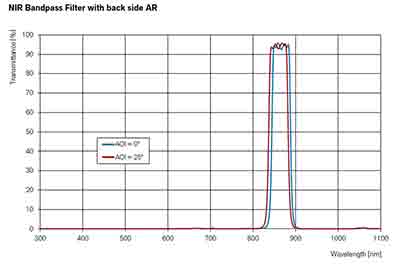Glass Subsrates for Bandpass Filter Fabrication
A senior microsystems engineer requested a quote for the following:
I need a 0.2mm thin glass similar to Corning Eagle Glass. Oone side is the bandpass filter coated like the picture below.
Size of the substrate is 4x4inch.

NIR Bandpass Filter with Back Side AR
Can you by any chance send me the raw data for the below curve. Or, in particular, I need to know:
- Amount of shift from 0 to 25 degrees. This is based on the effective index, neff , of the filter design. We may use slightly different materials than whoever designed / generated this curve, so the angle shift may vary some. Does this present any concerns?
- OD requirement for the out-of-band blocking. Since the graph is shown on a linear scale, it’s difficult to tell how much blocking the filter is providing outside the passband. Blocking level is a first order cost driver, so it’s important that we have a good understanding of the requirement.
To clarify, the glass you would be providing is 0.2 mm thick? Depending on the details, the glass thickness may be a non-starter for us due to the coating stresses. Can we coat the second surface of the glass to balance the stress?
Reference #236378 for specs and pricing.
Get Your Quote FAST! Or, Buy Online and Start Researching Today!
What is a Bandpass Filter?
A bandpass filter is an optical device that allows light of a specific wavelength range (or band) to pass through while blocking light outside of that range. These filters are essential in applications where it is necessary to isolate a particular portion of the spectrum, such as in spectroscopy, imaging, telecommunications, and laser systems.
Key Characteristics of Bandpass Filters
- Center Wavelength (λ₀): The central wavelength of the band of light that the filter is designed to
 transmit.
transmit.
- Bandwidth (Δλ): The range of wavelengths around the center wavelength that the filter transmits. It is typically defined by the full width at half maximum (FWHM), which is the width of the band at half of its maximum transmission.
- Transmission Efficiency: The percentage of light at the center wavelength that passes through the filter. High-quality bandpass filters have high transmission efficiency within the passband.
- Blocking Range: The range of wavelengths outside the passband that the filter blocks or reflects. Effective bandpass filters have deep blocking to prevent unwanted wavelengths from passing through.
- Optical Density (OD): A measure of the filter's blocking capability, typically specified in the blocking range. Higher optical density indicates better blocking performance.
Types of Bandpass Filters
- Absorptive Bandpass Filters: Made from colored glass or plastic materials that absorb unwanted wavelengths while transmitting the desired band.
- Interference Bandpass Filters: Utilize multiple layers of dielectric coatings to create constructive and destructive interference, selectively transmitting the desired wavelengths and reflecting or blocking others.
- Fabry-Pérot Interferometers: Consist of two parallel reflective surfaces that create multiple reflections, resulting in constructive interference at specific wavelengths.
How Bandpass Filters Work
Bandpass filters operate by leveraging the principles of interference and absorption:
-
Interference Filters: Constructed from multiple dielectric layers deposited on a substrate. These layers create a series of constructive and destructive interference patterns, which allow specific wavelengths to pass through while reflecting or canceling out others.
- Design: The thickness and refractive index of each layer are carefully controlled to achieve the desired passband characteristics.
- Performance: High-quality interference filters provide sharp cutoffs and high transmission within the passband, with deep blocking outside of it.
-
Absorptive Filters: Made from materials that inherently absorb certain wavelengths while allowing others to pass.
- Design: The material composition determines the specific wavelengths that are absorbed.
- Performance: Generally simpler and less expensive than interference filters, but may have lower transmission efficiency and broader passbands.
Applications of Bandpass Filters
- Spectroscopy: Isolating specific spectral lines for analysis.
- Imaging: Enhancing contrast by selecting a particular wavelength range.
- Fluorescence Microscopy: Exciting and detecting specific fluorescence wavelengths.
- Telecommunications: Filtering out specific wavelength channels in fiber optic communication.
- Laser Systems: Ensuring only the desired laser wavelength is transmitted, while blocking others.
Advantages of Bandpass Filters
- Selective Transmission: Precisely isolates the desired wavelength range, improving the accuracy and efficiency of optical systems.
- High Blocking: Effectively blocks unwanted wavelengths, reducing noise and interference.
- Versatility: Available in various designs to suit different applications and spectral ranges.
Summary
A bandpass filter is a crucial optical component designed to transmit light within a specific wavelength range while blocking out-of-band wavelengths. By using principles of interference and absorption, these filters enable precise control over the spectral composition of transmitted light, making them indispensable in many scientific, industrial, and technological applications.


 transmit.
transmit.